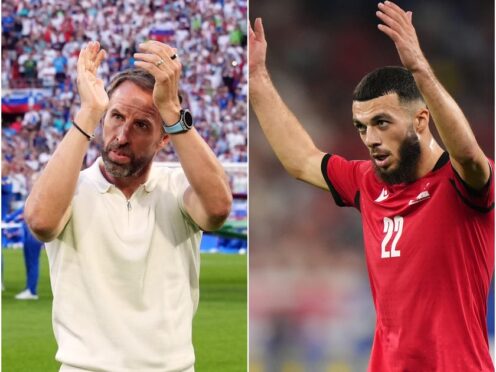Euro 2024’s group stage is over, with 16 of the 24 teams looking ahead to the knockout rounds.
Here, the PA news agency looks at the statistics that shaped the first phase of the tournament.
Fast start peters out

Goalscoring slowed after an exciting start to the tournament, with just 81 in the group stage overall for an average of 2.25 per match. For comparison, there were 94 in the Euro 2020 group stage en route to an eventual 142 (or 2.78 per match).
England’s Group C is the primary culprit, with no team scoring more than twice and the results reading like binary code – 1-1, 0-1, 1-1, 1-1, 0-0 and 0-0.
Groups A and F produced the most goals, 17 each, with Germany’s opening 5-1 win over Scotland the highest-scoring game and Georgia striker Georges Mikautadze the surprise group-stage leader in the Golden Boot race with three goals.
He is one of only six players to have scored more than once, with none until the 14th game when Jamal Musiala struck his second of the tournament for Germany. Team-mate Niklas Fullkrug, Dutchman Cody Gakpo, Slovakia’s Ivan Schranz and Romania’s Razvan Marin are the other players with two.
Kevin Csoboth’s goal in the 10th minute of added time for Hungary against Scotland was the latest of the group stage, while Mattia Zaccagni’s goal for Italy against Croatia eight minutes beyond the scheduled 90 helped them progress.
England’s slow progress

Despite finishing top of their group to set up a last-16 tie with Slovakia, England’s performances have been met with criticism.
Their win over Serbia produced just 11 shots, the lowest total on record in a European Championship game according to data company Opta, before they were held by both Denmark and Slovenia.
Gareth Southgate’s side have mustered just two goals – joint-lowest among qualifying teams and ahead of only Serbia overall – and 29 shots, with only Georgia and Slovenia of the qualified teams taking fewer.
They qualified with an identical record to much-fancied France – a win and two draws, scoring two goals and conceding one – but France took 47 shots, including 16 to the Netherlands’ eight in a goalless draw. England’s attempts also came from an average of 19.3 yards, sixth-furthest in the tournament.
One remarkable Opta statistic showed playmaker Phil Foden has completed more passes to goalkeeper Jordan Pickford (three) than to striker Harry Kane (one).
Upcoming opponents Slovakia scored three goals from 37 shots, upsetting Belgium 1-0 to help them qualify in third place in Group E. They used the oldest line-ups in the group stage, with an average age of 30.3 years compared to England’s 27.4.
Miscellaneous

Nine penalties were awarded in the group stage, with seven scored and Croatia responsible for the two misses – Bruno Petkovic against Spain and Luka Modric against Italy.
Only three red cards were shown, to Scotland’s Ryan Porteous in the opening game against Germany and Czech Republic pair Antonin Barak and Tomas Chory in one of the closing Group F double-header, a chaotic clash against Turkey also featuring 18 bookings.
Slovakia’s Group E was the first ever example of all four teams in a European Championship group finishing level on points, Ukraine the unlucky team to miss out on four points.
With 20 saves in Georgia’s three games, Giorgi Mamardashvili is seven clear of any other goalkeeper at the tournament.
Spain used the most players in the group stage, 25 with only third-choice goalkeeper Alex Remiro missing out. Belgium, Switzerland and the Netherlands used the fewest, 17 each, with England and Scotland among the teams using 18.
